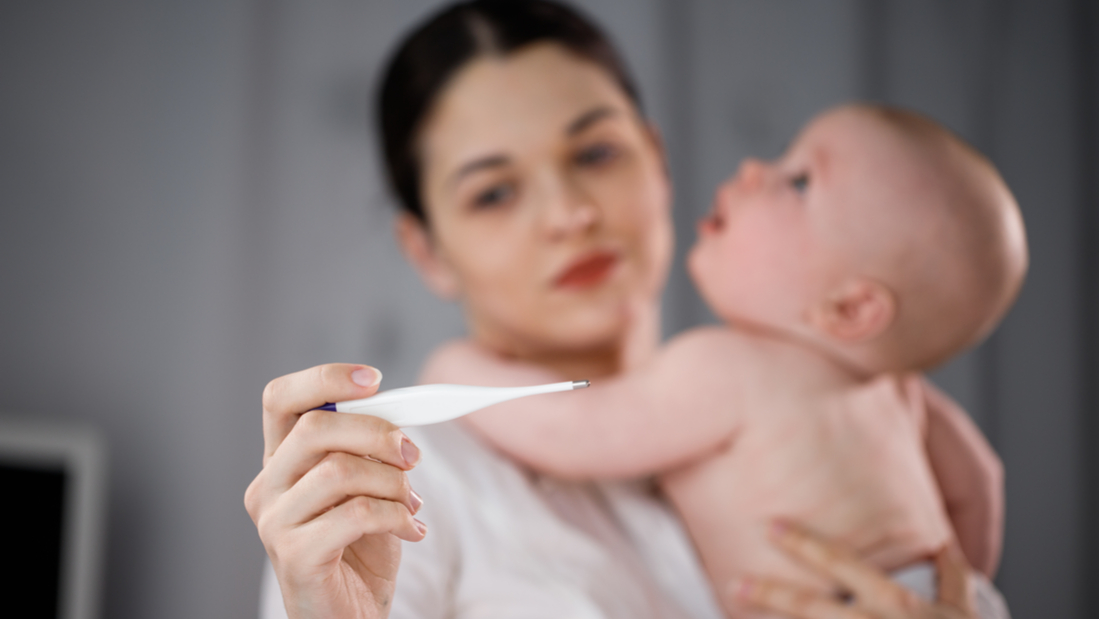Treating a fever in babies and children at home
In this article:
- How to treat a high temperature
- Medication
- Fluids
- Which other measures should I take?
- What symptoms should you be worried about?
- Main Points
- References

How to treat a high temperature
There is plenty you can do at home when your child has a fever (a high temperature of 38°C or above), but you should keep a close eye out for any of the signs described later in the article that suggest you need to seek urgent advice from a health professional.
Medication
Simple antipyretic medication such as ibuprofen (e.g. Nurofen) or paracetamol (e.g. Calpol) can be bought over the counter at any pharmacy or supermarket. As described above, a temperature is part of the normal response to an infection and it is generally not harmful in and of itself so does not necessarily need treating.
However, children with a high temperature are often miserable and distressed, and in this case it can be helpful to give them medication to treat this. Both paracetamol and ibuprofen bring the temperature down but work in slightly different ways. It is best not to give them both at once as they have different doses and they can easily get mixed up. You can give one and then, if the temperature has not settled a couple of hours later, give the other. Always follow the instructions as to how much to give your child based on their age and never exceed the total daily recommended amount.
Children with the following conditions should not use ibuprofen unless a doctor has specifically told you it is ok to do so:
- Heart, liver or kidney problems
- Bleeding problems
- Asthma triggered by non-steroidal anti-inflammatory drugs (NSAIDs)
Children under 3 months of age should NOT be given paracetamol or ibuprofen unless you have been advised to do so by a medical professional. All babies under 3 months with a temperature should be urgently seen by a health professional (see below for more information on this).
Paracetamol dosage for infants and young children
| Age | Dosage |
|---|---|
| 3 months to 6 months | 60 mg every 4–6 hours (maximum of four doses in 24 hours). |
| 6 months to 24 months | 120 mg every 4–6 hours (maximum of four doses in 24 hours). |
| 2 years to 4 years | 180 mg every 4–6 hours (maximum of four doses in 24 hours). |
| 4 years to 6 years | 240 mg every 4–6 hours (maximum of four doses in 24 hours). |
Ibuprofen dosage for infants and young children
| Age | Dosage |
|---|---|
| 3 months to 5 months | 50 mg three times a day (maximum of three doses in 24 hours, do not use for more than 24 hours). |
| 6 months to 1 year | 50 mg three to four times a day. |
| 1 year to 4 years | 100 mg three times a day. |
| 4 years to 7 years | 150 mg three times a day. |
Fluids
Another important thing to consider when looking after your child at home with a temperature or a mild infection is to ensure that they remain well hydrated.
When children have a temperature they naturally lose some fluid by sweating as this is one of the body’s ways to cool itself down. Also, when children are not feeling well, they may not be as interested in eating and drinking as much as normal and may have some diarrhoea or vomiting depending on what the infection is. When these things happen together, your child is at risk of becoming dehydrated and it is important to try and actively prevent this.
When children are unwell, they may refuse or be unable to eat for a day or so, and this is not a significant concern as long as they are managing to drink well and stay hydrated. Babies and younger children are often more interested in breastfeeding and bottles rather than solids when they are unwell, as these are a source of comfort.
If your child has had vomiting or diarrhoea, an oral rehydration solution (for example, Dioralyte) which contains some salt and sugar can help to replace some of the lost fluid and improve rehydration. If your child is still having regular wet nappies or passing regular amounts of urine, has moist lips, tears, and normal (not sunken) eyes, all this suggests they are not becoming significantly dehydrated.
On the other hand, a dry mouth or tongue, no tears when crying, sunken eyes, cool hands and feet, being drowsy, and (in babies) no wet nappies or a sunken soft spot on top of their head (fontanelle) can all suggest they are becoming dehydrated and you should seek urgent medical advice.
Which other measures should I take?
Some parents may try to cool their child down by sponging cool water onto them, but this has not been shown to help bring down a temperature and can cause uncomfortable shivering. Similarly, underdressing a child has also not been shown to be effective in reducing fever, and the amount of clothing should be dependent on the surrounding temperature to avoid either overheating or shivering.
Children who have a temperature are likely to be miserable and more clingy than usual; they will generally continue to seek out and respond to increased comfort from parents and other caregivers. It is sensible to keep your baby or child at home and away from nursery or school while they have a temperature.
You may like to check on your child more frequently than usual overnight while they are unwell with a fever.
What symptoms should you be worried about?
Any otherwise normal behaviour from your child can help to reassure you that he or she isn’t seriously unwell. Such as: if they are drinking well, are smiling and interacting with you as normal, are staying awake or are awakened easily when you rouse them, have a strong normal cry or are not crying, and have moist lips and tongue.
When their temperature is high, children are likely to be less interested in playing as normal, but if they go back to normal when their temperature settles – for example, after taking paracetamol – this is again reassuring.
Below are some of the worrying signs and symptoms for different age groups that mean you should take your child to see a health professional urgently:
- 3-6 months old and a temperature more than 39°C
- Pale skin
- Not smiling or interacting as normal
- Only awake when you stimulate them for a long time
- Breathing fast
- Nappies less wet or not passing much urine
- Poor feeding in babies
- Fever lasting 5 or more days
- Whole body is shaking with temperatures (also known as rigors)
- Swollen limbs/joints or not bearing weight or using a limb
- Having a seizure/fit (also known as a febrile convulsion)
Signs and symptoms suggesting your child is seriously unwell with a temperature and you should seek an urgent review of your child:
- Less than 3 months old and a temperature more than 38°C
- Mottled, ashen or blue skin, lips or tongue
- Not responding at all to interaction
- Not waking or staying awake when you stimulate them
- Weak, high pitched or continuous cry
- Grunting (forceful noise with every breath out)
- Struggling to breathe or breathing very fast
- Rash does that doesn’t disappear with the glass test
It is important to note that this is not an exhaustive list and if as a parent you are concerned about your child there are lots of places to go for help and advice. During normal hours you can visit a pharmacy or see your GP. Out of hours you can phone 111 or attend an urgent care centre or paediatric A&E.
Main Points
- Ibuprofen or paracetamol can be bought over the counter and used to manage a temperature (However, it’s best not to give them to your child at the same time). You must always follow the instructions when giving your child medication and never exceed the daily recommended amount.
- Ibuprofen is not suitable for children suffering from some conditions, such as heart, liver, and kidney problems, bleeding problems, and asthma triggered by NSAIDs.
- Children under three months with a temperature should be seen urgently by a healthcare professional.
- You must ensure that if your child has a temperature, you must ensure they stay well hydrated.
- Signs of dehydration in children include a dry mouth or tongue, no tears when crying, sunken eyes, cool hands and feet, and drowsiness.
- Signs of dehydration in babies include no wet nappies or a sunken fontanelle.
- Some measures such as sponging your child with cool water and undressing them to try to lower their temperature have not been proven to be effective.
- You should keep your child away from nursery or school if they have a fever.
- There are several worrying signs and symptoms for different age groups that you should look out for if your child has a fever. If you notice your child isn’t smiling or interacting as normal, is breathing quickly, or their whole body is shaking, you should take them to be reviewed by a health professional.
- There are also signs that your child requires urgent medical attention. These include struggling to breathe, not waking when you stimulate them, and having mottled, ashen or blue skin, lips or tongue.
References
Fever in under 5s: assessment and initial management https://www.nice.org.uk/guidance/cg160



